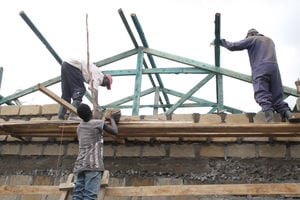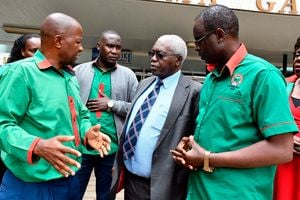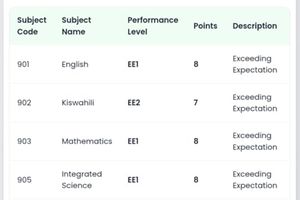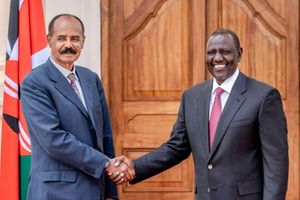
Grade 9 learners at Xaverian Eye Primary and Junior School have resumed classes after the long Christmas holiday break on January 6, 2025.
Congestion, confusion, and shortage of teachers marked the first day of Grade 9 when more than one million learners of the pioneer curriculum-based curriculum (CBC) reported to school on Monday, January 6.
Despite government assurances that all is ready, Nation Africa spot checks across the country tell the story of learners forced to share classrooms while others will use makeshift structures as they wait for the construction of classrooms. While most schools have received textbooks, a few others began the school term with the learning resources.
However, Education Cabinet Secretary Julius Ogamba downplayed the concerns, saying that the government is on track with rolling out the last class of the junior school.
In Kilifi County, some schools are still waiting for the government to construct Grade 9 classrooms. School heads from Ganze Sub-county released the tender invitation letters to construct the classrooms on December 29, 2024, while the tender documents were opened on January 6, 2025, as learners reported to the school.
Kilifi Primary School head teacher Emmanuel Karuke said the school has 186 Grade 9 learners. Six teachers have been deployed to teach junior school (Grade 7, 8, and 9).

Grade 9 pupils in class at Tom Mboya Comprehensive school in Mombasa County on January 6, 2025 as the new school calendar begins.
“We are set and ready for learning. The government constructed two classrooms for us,” he said.
Kibaoni Primary School head teacher Charles Gona, said the school has 244 learners.
“Three-quarters of the learners reported on Monday (January 6) and those who are yet to report are those that might have travelled upcountry and we expect them even by Tuesday,” he said.
Mr Gona said the school did not have specific Grade 9 classrooms.
“We have a room to accommodate them as we wait for the Ministry of Education but we are not badly off. The students have a place to sit and learn,” he said.
Grades 7 and 8 are learning in two classrooms that were constructed by the Kilifi North National Government Constituency Development Fund (NG-CDF). The Kenya Primary School Heads Association (Kepsha) national vice chair Fuad Ali said more than 100 Grade 8 learners from Tom Mboya Comprehensive School in Mombasa County, where he teaches, transited to Grade 9 without any hitch.
“We have received all the textbooks. We are all back to school, and learning has resumed,” said Mr Ali.
He said he had received more than 50 requests from parents wishing to transfer their children to the school.
Speaking in Kajiado North Sub-county on Monday, Mr Ogamba said the Ministry of Education has constructed 14,500 classrooms out of the targeted 16,000 allaying fears some Schools have opened without Grade 9 classes.
He said the Ministry of Education will be keen to ensure the construction of new classrooms in remote areas to accommodate all the learners under CBC.

A guardian assist his son carry his school box as they head to catch a matatu in Nakuru City on January 6, 2025. Majority of schools opened for Term One.
“Schools which have not received textbooks will receive them in the week. We are committed to ensuring all learners have access to the textbooks. Let parents know there is no course of alarm," he said.
Kajiado North MP Onesmus Ngogoyo said the lack of desks and classrooms has been a major setback to the 100 per cent transition policy.
In Laikipia County, some school heads have resorted to improvisation to address the twin problems of shortage of junior school teachers and classrooms.
“Newly recruited teachers are few. The others said to have been employed were already in service working as interns. Though the government is on the right path on infrastructure development, which currently stands at 75 per cent in Laikipia, the major crisis is the shortage of junior school teachers,” said Jackson Thangei, the Laikipia Kenya National Union of Teachers (Knut) executive secretary.
The Nation established that classrooms for Grade 9 are complete in a number of schools, including Nanyuki Primary, St Moses, Likii Primary, and DEB Primary. However, teachers from the primary section had been assigned to teach in junior school to bridge the staffing gap.

Newly admitted pupils from St Mary's Primary school, a public institution in Nakuru City enjoy their lunch meal at the institution after undergoing orientation on January 6, 2025. The institution is among the few institutions with five completed new classrooms that will host Grade Nine.
In schools where construction of the classrooms has not started or is incomplete, school management was forced to look for innovative ways to accommodate the Grade 9 learners.
At Nkando Primary School, Grade Seven learners from two streams are now studying in one room to create space for Grade 9 while at Kairigire Primary in Umande Ward, the staffroom has been converted into a classroom to accommodate the learners.
In Meru County, the director of education Joseph Maki said about 348 Grade 9 classrooms were under construction, with many ready for use. There are more than 600 public primary schools in Meru County.
The Kenya Primary School Heads Association chairman Kiragu Guantai said while several schools were prepared for Grade 9, many classrooms were not complete.
“Some of the classrooms funded by the Ministry of Education are not complete because of delays in releasing funds. We are hoping that all schools will have their classrooms ready by next week,” Mr Guantai said.
However, in North Imenti, area MP Rahim Dawood earlier said there was a shortage of 29 Grade 9 classrooms in the constituency and that the NGCDF committee had sought approval to build 12 classrooms.
At Umoja Mbuyu Primary School in Ndaragwa Constituency, Nyandarua County, Grade 9 learners remained at home for lack of a classroom. Those who reported later returned home.
“My son left for school early morning but returned home soon after. She was told the school does not have a classroom for them, and we do not know how long they’ll remain at home,” said Ms Stella Nyokabi, a parent.
In Narok County, overcrowded classrooms, a shortage of desks, and a lack of enough teachers were reported as key concerns.
Many schools in the region, including Nairenke, Nakurto, Namelok, Nkaampani, Limanet, and Soget lack the critical infrastructure to accommodate the learners.
However, in some of the schools visited by Nation, like Masikonde Primary School, there is notable progress in preparedness for Grade 9. The school has secured additional desks and renovated some classrooms.
In Nakuru County, some of the primary schools in far-flung areas visited by the Nation have overcrowded Grade 9 classrooms. These include; Lemechonik, Haraka, Kamara, and Chesingele primary schools in Kuresoi North and Bavuni, Nyathuna, and Mereroni in Bahati. Others are Kieni and Shunem in Subukia.
The head teacher of Maralal DEB Primary School in Samburu County said that the construction of seven new classrooms has been successfully completed and there are plans to add two more. Mr Boniface Lonyait said the classrooms will accommodate over 360 learners.
"We have 327 learners already, and we anticipate to get about 50 from other schools. The additional classrooms will help ease overcrowding and provide a conducive learning environment for our learners," Mr Lonyait said.
Reporting by Tobby Messo, Eric Matara, Stanley Ngotho, Geoffrey Ondieki, Vitalis Kimutai, Winnie Atieno, Maureen Ongala, Mwangi Ndirangu, David Muchui and Waikwa Maina









